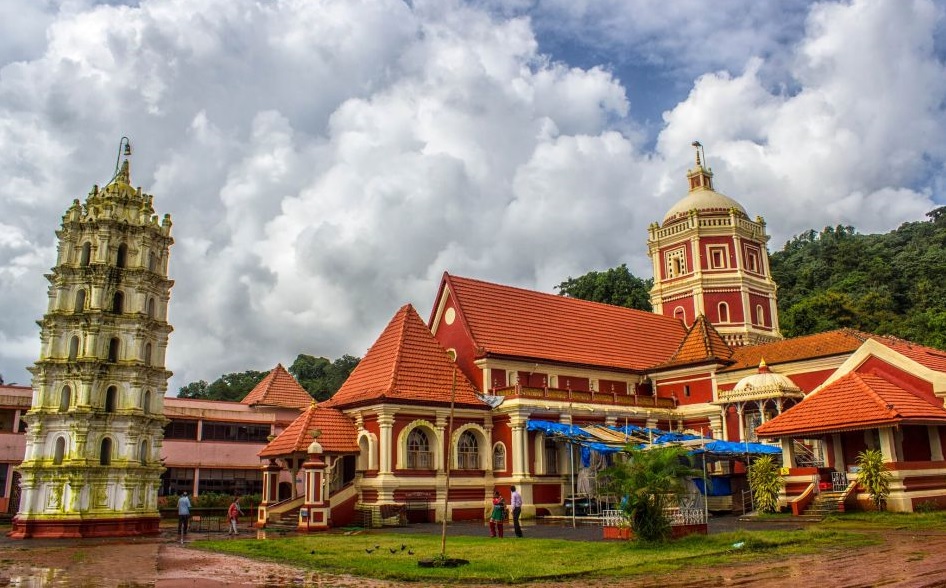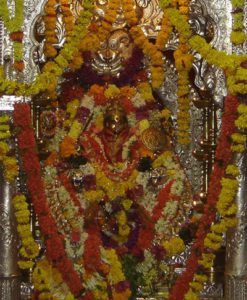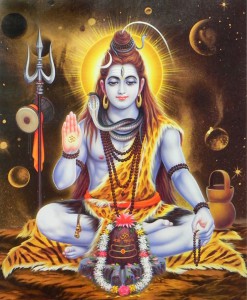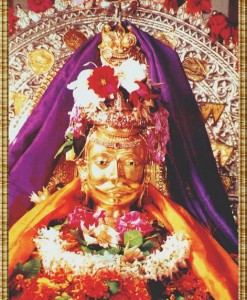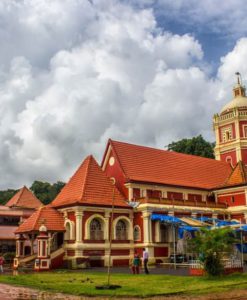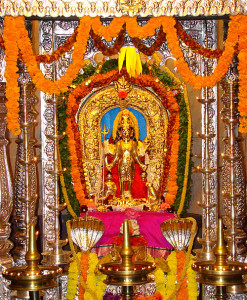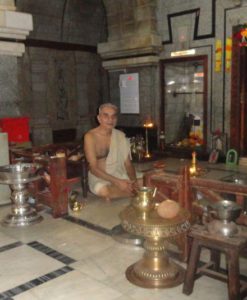No products in the cart.
Shri Shantadurga Temple, Kavlem
Shri Shantadurga Temple is a large temple complex 33 km (21 mi) from Panaji at the foothill of Kavlem village in Ponda Taluka, Goa, India. A small laterite mud shrine was built and the deity was installed here. The mud-shrine was converted into a beautiful temple whose foundation stone was laid in 1730 and the temple was completed in 1738 and renovated in 1966.
Shri Shantadurga temple was originally at Keloshi. In Keloshi Shree Shantadurga Devi was known as Santeri devi and was worshipped by that name. Shree Shantadurga’s temple was built at Keloshi by an affluent merchant, Anu Shenai Mone.
With the advent of the Portuguese in Goa and the increasing missionary activities, the community was afraid for the safety of the temples and idols. Hence the families worshipping Shree Shantadurga and Shree Mangesh, on a moonless night, leaving their homes and hearths behind crossed over the Juari river (also known as Aghashashini or Agashi river) with the images (murti) of the deities and the linga on their heads and shifted to the region under the rule of Muslim king Adilshaha. Via Dandi they reached the village Kavalem in Antruj village and chose a site with beautiful surroundings to install the image of Shree Shantadurga. It is indeed surprising that a new place could be found by the devotees for installation of Shree Shantadurga with exactly the same scenic beauty as available at Keloshi. The patron deity Shree Mangesh was installed in Priyol in Ponda Taluka. The place is now known as Mangeshi (its original name is not known though some believe that it was earlier known as Ganapati Wada). Antruj was too small a place to accommodate all the G.S.B.families who went there to escape the Portuguese harassment. They naturally dispersed in all directions but always regarded the temples as a link between them. Their voluntary contributions and later active patronage of Peshwas improved and enriched the temples.
There is some confusion regarding the exact date of shifting of these deities to a new place. However, as per the Portuguese records the deities were shifted sometime between 14 January 1566 and 29 November 1566. Shortly after shifting, both the original temples got demolished. Now the plot on which the original temple of Shree Shantadurga stood at Keloshi is known as “Deoolbhata” and it is in the possession of the temple trust. However, at Kushasthali it is believed that a Church stands in place of Shree Mangesh temple.
The village Kavalem belonged to the Harijan community. The people from the village were kind enough to provide a 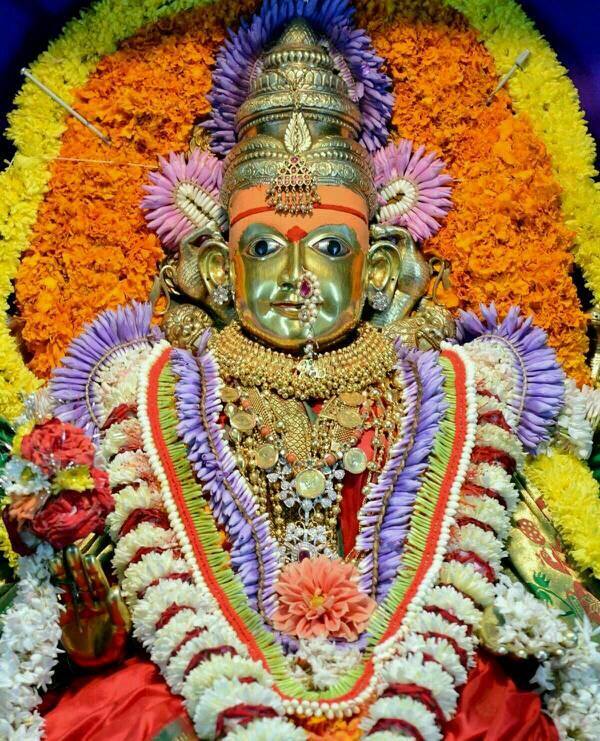 safe place for installation of the Devi. The idol of the Devi was installed in a small house in that village. After some time the house where the Devi was placed took form of a small temple and regular prayers were held in the temple.
safe place for installation of the Devi. The idol of the Devi was installed in a small house in that village. After some time the house where the Devi was placed took form of a small temple and regular prayers were held in the temple.
The devotees of Shree Shantadurga did not forget the kindness shown by the Harijan community by providing a safe place for the Devi. All the people from the community were invited to the temple and were felicitated. This incident took place on Magha Shukla Shashthi day. Since then every year on the Magha Shukla Shashthi day the temple authorities invite the Harijans from the Kavalem and honour them by presenting them with Devi’s saree, blouse piece, coconut, etc. This custom is being observed for the last four centuries without fail.
During those days, that part of Goa was ruled by a Muslim ruler, Adilshah and his representative for the area was a person called Sardesai, who belonged to the Saraswat community. This gave a sense of security to the community and patronage from the ruler for the temple. Shri Sardesai would always be present for the palkhi processions taken for the Devi. And slowly it became a custom to start the palkhi procession only in the presence of a member of the Sardesai family.
There are no records with the Temple trusties to indicate the exact time when the temple was constructed at the current location [Kavlem]
However, the records available establish that the current structure of the temple was in existence between 1713 A.D. and 1738 A.D. During the 20th century, the structure of the temple underwent repairs from time to time for maintenance and renovation.
The inspiration to build the temple was given by the Goddess (Devi) Shree Shantadurga to Shri Naroram Mantri. Shri Naroram Mantri was originally from Kochar village in the Vengurla region. His full name was Naroram Shenvi Rege and he was called Naroram Mantri as he was a Mantri [minister]
in the Shahu Chatrapati’s Court during the period 1723 a.d. He believed that he could attain the fame and fortune only because of the blessings of Shree Shantadurga devi. He felt that he should build a new temple for the Devi with his own money. He started building the temple building around 1730 a.d and with the help from other mahajans, the currently huge and beautiful temple was completed. Due to his efforts the village Kavalem was given as a gift to the temple by Shahu Maharaja in the year 1739 a.d . Shri Naroram Mantri also gave many donations to the temple. In view of his priceless contribution in making of the temple, Shri Naroram Mantri and his descendents are given the highest respect next to our Dharmaguru/Swamiji. His descendents get all the respect and facilities from the temple people and trust whenever they visit the temple. They have a reserved place in the temple for sitting during the pujas and arti. The place near the middle pillar on the northern side in the temple is reserved for this family. This pillar is called the Mantri Khamb [pillar]
For bringing them from their house to the temple, people with mashal (lighted torch) are sent. Also, any kind of musical program held in the temple in their presence is concluded only after obtaining their permission. His descendents also have the right to see the Prasadvastra of Devi [cloths offered to the Devi by the devotees] before leaving Kavlem.
The original temple at Quelossim (Keloshi) in Salsete was destroyed by the Portuguese in 1564. The goddess was shifted to Kavalem and worship was continued there. The site on which the original Temple of Shantadurga stood at Quelossim (Keloshi) is known as “Deoolbhata” and it is in the possession of the Temple Committee.
The current temple was constructed during the reign of Maratha ruler Chattrapati Shahu of Satara in about 1738 A.D. Naroram Mantri (Naroram Shenvi Rege) originally from Kochara village in the Vengurla region was a Mantri (minister) in Shahu’s Court (Grandson of Shivaji Maharaj)around 1723. He obtained finances to construct the new temple for the goddess from Shahu. The temple construction started around 1730 and, with the help from other mahajans, the present temple was completed. Due to his efforts, the village of Kavalem was bequeathed to the Temple by Shahu in 1739.
The temple complex is on the slope of the foothills of a mountain chain, surrounded by lush vegetation. There is a main temple and three smaller temples of other deities which have been built on three sides of the temple. The temple consists of a collection of pyramidal roofs with a dome. The pillars and floors are made of Kashmir stone. The temple has a huge tank, a Deepastambha and agrashalas (guest houses).
Many renovations have been completed over the years to the main temple and the temples of the other deities as well as to the agrashala. The temple has recently banned entry of foreigners into the temple citing objectionable dressing and conduct as the reason.
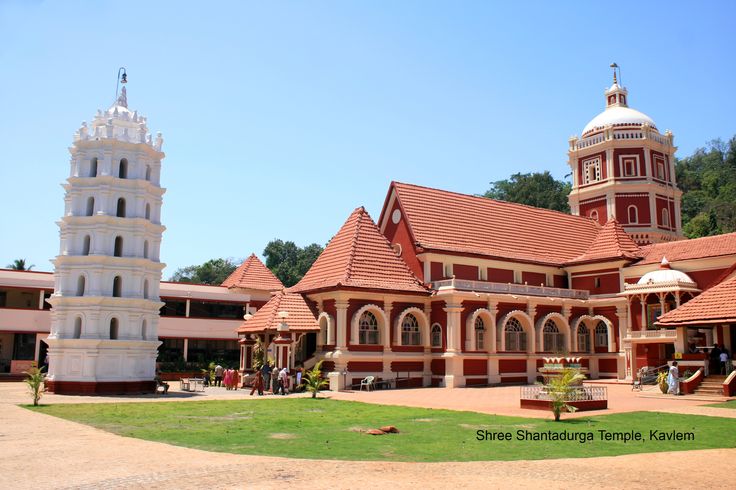
By Road: Shri Shantadurga Temple is a large temple complex 33 km (21 mi) from Panaji at the foothill of Kavalem village in Ponda Taluka, Goa, India.
By Rail: The nearest railway station present to the temple is Karmali Railway Station.
By Air: The nearest airport present is Panaji Airport.
Shri Shantadurga Temple, Kavlem
The opening and closing time of the temple are: 5:00 AM to 10:00 PM. Here daily rituals of Goddess Shanta Durga are performed.


